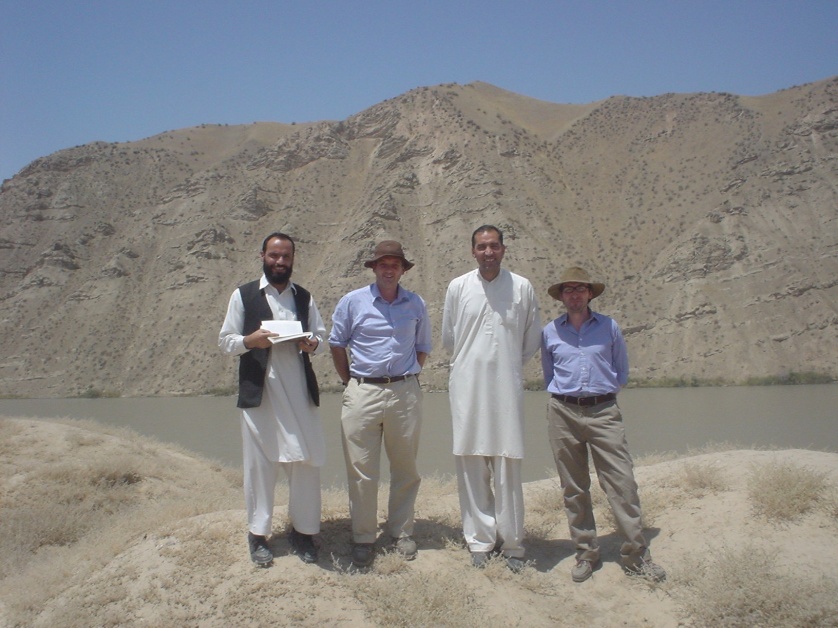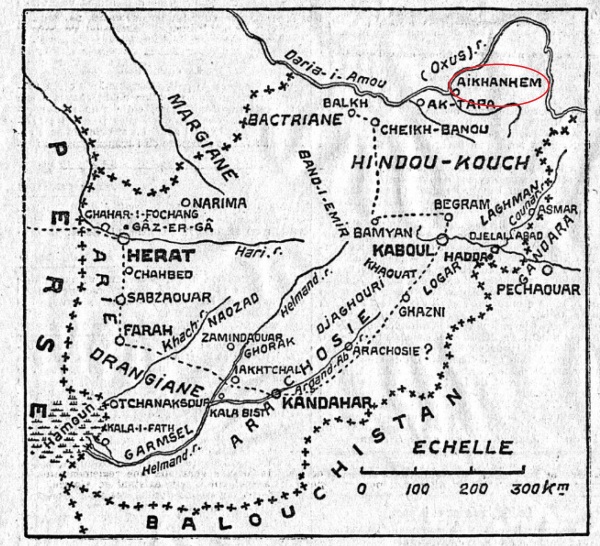A more misleading title to a blog you will never see. There’s no murder here, no crime at all. No tension or thrill for that matter. There is a slight mystery, maybe even a touch of deceit, but I’d be kidding you if I pretended this was anything other than the most self-indulgent blog I’ve ever written. Not least because it’s about Afghanistan, a place I keep trying not to write about. It’s just too fascinating.
In 2008 I got to visit Ai Khanum, an archaeological site on the northern border of Afghanistan. It is not an easy place to get to, and it was one of the highlights of my life, an unforgettable 40th birthday present from Alan MacDonald, at the time based in Afghanistan with MACCA, the Mine Action Coordination Centre of Afghanistan. Here I am at the site, the River Oxus and Tajikistan behind me, feeling short alongside Alan and two Afghan MACCA officials, Mohamed Shafiq and Sayed Aga.
Even without the archaeology Ai Khanum is a stunning location, set in the angle created by the confluence of the Amu Darya (Oxus) and the Kokcha rivers. The site was dug by French archaeologists in the sixties and seventies, and they found some quite spectacular things. It was a city established by Alexander or one of his successors 3,000 miles away from Greece, but equipped with characteristically Greek things like a theatre, gymnasium and stocks of olive oil, even Greek texts: the texts themselves, parts of a philosophical dialogue and a tragedy, weren’t found, but the imprint of their ink had been left on the earth.
Much of what was brought to light at Ai Khanum illustrated the nostalgia of the Greek colonists for their homeland, and there was plenty of evidence also of the compromises they were obliged to make with their new and radically different environment. The city traded in the most famous product of its hinterland in Badakhshan, lapis lazuli, and some of the city’s architecture, and by implication some of its religion, politics and social life, was more middle-eastern than Greek. But however one cuts it, Ai Khanum represented a fascinating encounter between Greek and non-Greek culture.
My very favourite artefact, probably the main reason I wanted to see the place, was a visually unappealing block of stone inscribed with Greek, some lines on the ideal life (originally inscribed at the oracle of Apollo at Delphi, in Greece) and a poem explaining how a man called Clearchus had travelled all the way from Delphi to Ai Khanum and set up the monument when he arrived. There’s more on Ai Khanum and Clearchus’ inscription here; a 3D video tour of the reconstructed city here; and a while back I tried to explain the significance of Clearchus’ journey here. The Delphic wisdom was as follows:
Παῖς ὢν κόσµιος γίνου
ἡβῶν ἐγκρατής
µέσος δίκαιος
πρεσβύτης εὔβουλος
τελευτῶν ἄλυποςAs a child, be orderly,
As a youth, be self-controlled,
As an adult, be just,
As an old man, be of good counsel,
When dying, feel no sorrow.
So, an exciting archaeological site for any Classicist, but especially one with a thing about Afghanistan like me. But that’s not quite what I’m concerned with in this blog. Ai Khanum was excavated from 1964-78 by the archaeologists of DAFA, the Délégation Archéologique Française en Afghanistan. Something that has intrigued me for a long time is the official account of how the site was originally discovered in the sixties. In 1961, the story goes, the king of Afghanistan, Zahir Shah, was shown some impressive archaeological fragments (one of them a large Corinthian capital) during a hunting expedition. He then summoned the Director of DAFA, Daniel Schlumberger, to an audience, and requested that the archaeologist visit the site to assess what he had seen. It’s a great story, the King inspiring the archaeological investigation of Afghan history, and I suppose that’s exactly what makes me suspicious.
Ai Khanum had certainly been “discovered”, in some sense, earlier than 1961. In 1836-8 Captain John Wood, on the skirts of a mission to Kabul led by the greatest of the Great Game operators Alexander Burnes, travelled through what is now north-eastern Afghanistan, then the territories of the terrifying ruler of Qunduz, Murad Beg, tracking the course of the river Oxus to its source, or at least one of its sources. Later, on 18 March 1838, during a journey out from Qunduz with Dr Perceval Lord (whose medical treatment of Murad Beg’s brother had been what gained Wood access in the first place), he visited “I-khanam” where, he was informed by locals, “an ancient city called Barbarrah” had stood. A century later in 1926, in the very early days of DAFA (which was established in 1922 by agreement between Amanullah, King of Afghanistan, and the French archaeologist Alfred Foucher), Jules Barthoux set off on a tour of northern Afghanistan in search of promising sites for investigation. One of them was “Aï Khanem”, identified in Barthoux’snotes, in Foucher’s report of his tour to the Académie des Inscriptions et Belles-Lettres in Paris, and even on a map of Afghanistan in an article in the French national newspaper Le Temps on 6 July 1930, as a place of archaeological interest.
Source: gallica.bnf.fr
Now, a lot happened between 1926 and 1961, and Barthoux had parted company from DAFA on poor terms. There’s also a difference between a general sense that there’s something very old to be found, and the very specific pieces of Greek archaeological material to which Zahir Shah alerted Schlumberger. So I’m prepared to believe that Barthoux’s information about Ai Khanum had been forgotten by the sixties, or at least that it hadn’t struck anybody as of urgent importance. The same could be said for John Wood’s account in A Personal Account of a Journey to the Source of the Oxus, although Paul Bernard, who directed the excavations at Ai Khanum, did later base some speculative but very interesting arguments about its early history on Wood’s account.
Let’s assume, at any rate, that it took Zahir Shah’s intervention to alert Daniel Schlumberger and Paul Bernard to the archaeological potential of Ai Khanum. I’m not so sure that it was such a revelation for the King of Afghanistan himself.
In 1923 Burhan al-Din Kushkaki published Rahnuma-ye Qataghan wa Badakhshan, an abridged version of a report by Mohamed Nadir Khan of a tour of north-eastern Afghanistan in 1921-22. Nadir Khan was at the time Minister of Defence, and he and three other ministers had been dispatched by the reforming King Amanullah, shortly after his accession in 1919, to report on various parts of the country. In effect, the Rahnuma was part of Amanullah’s Domesday Book. One of the places visited by Nadir Khan was called ای خانم, Ai Khanum, “which in ancient times had been a city”. Like all previous visitors to the site, Nadir Khan noted the traces of buildings still visible.
Nadir Khan later became king himself, after Amanullah’s overthrow in the events I described here. But probably the most relevant thing about Nadir Khan is that he was the father of Zahir Shah, the king who supposedly discovered Ai Khanum on that hunting expedition in 1961. The Rahnuma was translated into Russian in 1926, for obvious reasons given the proximity of the Soviet Union. It wasn’t translated into French until 1979. But while the archaeologists of DAFA were very likely unaware of it, I doubt that Zahir Shah was.
What I wonder is whether Zahir Shah had reasons over and above an interest in archaeology to push DAFA towards Ai Khanum at this time. Something to be understood is that Zahir, though king, was not the real power in Afghanistan at the time. As Tamim Ansary explains in Games without Rules, his wonderfully readable history of modern Afghanistan, since 1929 Afghanistan had been ruled less by individuals than by a family, or “the Family”, as Ansary calls it, the collectivity of the male members of the Musahiban clan. In 1961 real power resided with Daoud, Zahir’s cousin, officially the Prime Minister. A couple of years later, in 1963, Zahir Shah managed to sideline Daoud, assume power himself, and enact sweeping democratic reforms. In 1973 Daoud took power back from Zahir, but in the process unleashed the radical left-wing forces which would see Daoud ousted and killed in 1978. Up until 1978, however, change of regime in Afghanistan was actually just a reshuffling of the Musahiban cards, the result of internal, and necessarily largely invisible, politicking within the Family.
I think we can see hints of this politicking in the events surrounding Ai Khanum in 1961. Zahir Shah had encouraged Schlumberger to visit Ai Khanum, but Schlumberger had to return to his university in France for a spell and deputed another French archaeologist to go in his place, Marc Le Berre. The King gave Le Berre authorisation to travel to Ai Khanum, but the local governor refused him access. Eventually Schlumberger visited the site in December 1962, and was convinced of its importance. In a report Schlumberger commented on the fundamental importance of securing the approval of the Prime Minister, Daoud, for their proposed excavations. And yet Zahir Shah by his initiative, aided by the spectacular character of the archaeological site he had brought to DAFA’s attention, got his way.
I don’t think it’s too hard to see this as the King using the foreign archaeological mission to assert his own authority. What made Ai Khanum especially sensitive was its location right on the border with the Soviet Union. Generally the French archaeologists in Afghanistan avoided going near the borders; as it was, a token number of Soviet archaeologists were included in the team when excavations got fully under way in 1965. But an exciting, internationally significant archaeological excavation on the Soviet border initiated by the King had its own symbolism. When Zahir Shah ousted Daoud shortly after, the new policies involved, among other things, a turn away from Daoud’s reliance on the Soviets, an opening up to the outside world, an emphasis on cultural openness and education. Internally and externally, it seems to me, the processes that Zahir Shah kicked off by his audience with Daniel Schlumberger answered to those aims rather precisely.
Well, maybe, maybe not. But I’d like to believe there was more to Zahir Shah’s hunting trip than meets the eye.
A few things last week set me thinking again about this question. The main one was a Twitter conversation with Mary Munnik in which it came home to me, for far from the first time, how utterly opaque Afghan politics are to me, ancient, medieval and modern. That should be borne in mind when assessing my musings above: I really and honestly don’t have a clue, but I can’t help but find it all thoroughly fascinating.
I’ve read or re-read some interesting stuff on DAFA, Zahir Shah, and Ai Khanum in the last few days:
Tamim Ansary, Games without Rules (2012);
Paul Bernard, ‘Aï Khanoum “La Barbare”‘ & ‘La découverte du site grec et de la plaine d’Aï Khanoum par John Wood’, in Paul Bernard & Henri-Paul Francfort, Études de géographie historique sur la plaine d’Aï Khanoum (Afghanistan) (1978), 17-23 and 33-8;
Rachel Mairs, The Hellenistic Far East: Archaeology, Language, and Identity in Greek Central Asia (2014);
Françoise Olivier-Utard, Politique et Histoire: Histoire de la Délégation Archéologique Française en Afghanistan (1922-1982) (1997);
Marguerite Reut, Qataghan et Badakhshan, par Mawlawi Borhan al-Din Koshkaki Khan (1979);
Zamariallai Tarzi, ‘Jules Barthoux : le découvreur oublié d’Aï Khanoum’, CRAI 140 (1996), 595-611.


No comments:
Post a Comment